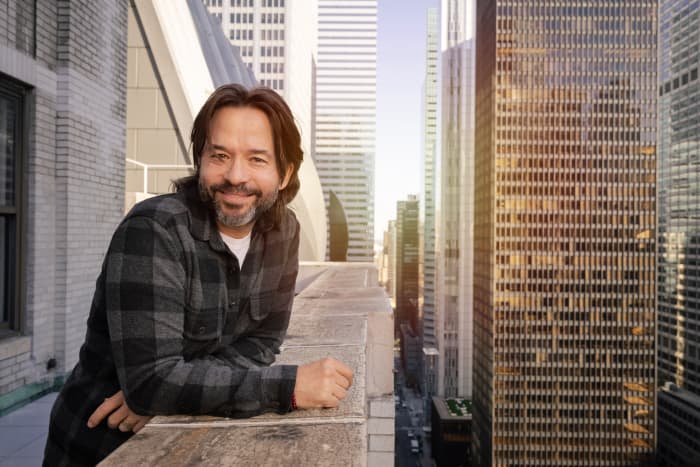Donation is believed to be ‘biggest that we’ve ever seen in the psychedelics space.’ Quest for treatments for depression, PTSD centers on MDMA, psilocybin and similar drugs.
A nascent category of mental-health treatments is getting a major cash infusion.
Blake Mycoskie, founder of the Los Angeles–based canvas-footwear phenomenon Toms Shoes, has committed to giving $100 million to support psychedelic research and access, Mycoskie told MarketWatch in an exclusive interview. The money will help fund academic institutions investigating psychedelics’ potential to treat anxiety, depression, post-traumatic stress disorder and other mental-health issues, as well as nonprofits helping to connect patients in need with psychedelic treatments.
Traditional psychedelics include hallucinogens like LSD and psilocybin, or “magic” mushrooms, recently legalized in Oregon and Colorado. Other drugs that can alter mood and perception — such as ketamine and MDMA, also known as ecstasy — aren’t classical psychedelics but are broadly included in the research and policy discussions generating a surge of interest in this class of treatments. The U.S. Food and Drug Administration, for example, has granted psilocybin and MDMA “breakthrough therapy” status, a designation designed to expedite development and review of drugs for serious conditions, and could approve MDMA for treatment of PTSD as soon as next year.
Also see: Jets quarterback Aaron Rodgers talks about mental health at psychedelics conference
Given the rapid developments in the field, ”we really need to get this right, and we really need to have these foundations and nonprofits funded properly,” therapists trained, and clinics open and running smoothly, Mycoskie said. “I felt a real sense of urgency,” he said, and asked his wealth manager, “What’s the most that I can give?”
The $100 million answer to that question amounts to about a quarter of Mycoskie’s net worth and marks a major milestone in psychedelics’ delicate image transformation. Shedding some of their dangerous-party-drug reputation, psychedelics are gaining attention from top pharmacologists, the scientific community, biotech companies and investors who see them as a critical part of the solution to a U.S. mental-health crisis.
Cracked open
Mycoskie, 46, said his interest in psychedelics dates back to 2017, when a friend returning from a trip to Central America described his experience with ayahuasca, a plant-based psychedelic brewed into a tea. As an entrepreneur under intense pressure to perform, Mycoskie said, he decided to try it for himself. The experience “cracked me open, and it connected me more to my faith in God, made me feel that we were all connected and everything was fine and perfect,” he said. “I came back just feeling like, wow, that was more powerful than any therapy I’d ever done.” He later tried MDMA-assisted therapy, he said, which also helped him process issues that traditional talk therapy had left unresolved.
Believing that many people could benefit from similar treatments, Mycoskie started giving money to academic groups and the Multidisciplinary Association for Psychedelic Studies, or MAPS, a nonprofit organization. He also got involved in last year’s Colorado ballot initiative, which legalized psilocybin and several other psychedelic substances, including ibogaine, which has shown potential to treat substance-use disorders. Mycoskie has already given about $10 million to psychedelic research and access, he said, and plans to give about $5 million annually for 18 more years.
Mycoskie was a bit squeamish at first, he acknowledges, about publicly backing research on drugs that are largely illegal. “Am I going to get held up at TSA every time I go through the airport?” he remembers wondering. The U.S. Drug Enforcement Administration categorizes LSD and MDMA alongside heroin as “Schedule I” drugs, defined as “drugs with no currently accepted medical use and a high potential for abuse.” But with growing public awareness and acceptance of the drugs’ potential as mental-health treatments, he said, he felt emboldened to make a big public commitment, and “the research has caught up,” he said. “It’s important that people like myself put their name out there and their money out there to show that this really is a path forward,” he said.
Mycoskie’s $100 million commitment “is the biggest that we’ve ever seen in the psychedelics space,” said Joe Green, president of the Psychedelic Science Funders Collaborative, a nonprofit supporting philanthropy in the field, and a MAPS board member. Now that research has made great strides to support use of the medicines as mental-health treatments, that money can help ensure that “these actually come to the world in a safe and beneficial way,” Green said. With certain treatments legalized in Oregon and Colorado, for example, “the system requires licensed guides, facilitators, licensed service centers,” he said. “It’s not like cannabis medical–you won’t be able to take the mushrooms outside the service center.”
Psychedelic therapeutics market could be worth more than $8.3 billion by 2028
Mycoskie plans to publicize his pledge at the Multidisciplinary Association for Psychedelic Studies’ psychedelic science conference — billed as “the largest psychedelic conference in history” — this week in Denver. On the agenda: sessions ranging from state policy and regulatory considerations to clinical trials of psilocybin- and MDMA-assisted therapy and “sex and psychedelics: weaving altered states for healing and pleasure.”
The news comes as lawmakers on both sides of the aisle are pushing for new funding for research into the use of psychedelics to treat PTSD in military service members as part of the fiscal year 2024 National Defense Authorization Act, which the House Armed Services Committee will consider Wednesday.
Already, public companies like Atai Life Sciences
, Compass Pathways
and Cybin
are developing therapies based on psychedelic substances. The psychedelic therapeutics market could be worth more than $8.3 billion by 2028, according to InsightAce Analytic. Even the federal government is throwing money at this niche, funding efforts to develop psychedelic mental-health treatments without the hallucinogenic side effects.
More than one in five U.S. adults lives with a mental illness, according to the National Institute of Mental Health, and less than half of the roughly 58 million adults with any mental illness are receiving treatment. Suicide rates, which have been on a long upward trajectory, declined briefly between 2018 and 2020 before returning to peak levels in 2021, according to the Centers for Disease Control and Prevention. Nine out of 10 U.S. adults believe the country is suffering a mental-health crisis, according to a survey last year by CNN and KFF, a health-policy nonprofit. And commonly prescribed antidepressants, such as selective serotonin reuptake inhibitors (SSRIs) don’t work well for many patients.

Nushama, a New York psychedelic wellness center that offers ketamine-based therapy delivered through in-person IV infusions, hopes to expand into MDMA. PHOTO: COURTESY OF NUSHAMA AND COSTAS PICADAS
Mental illness “is truly an epidemic, and we are losing the fight,” said Dylan Beynon, CEO and founder of Mindbloom, which offers a telehealth ketamine treatment program. While there are some existing solutions that are helping to bend the curve, he said, more research and educational support for providers and patients is needed, he said.
Indeed, some substantial hurdles still separate psychedelic mental-health treatments from many of the patients they might benefit, including a lack of insurance coverage for the currently legal treatments and debate over how to administer them safely. In the case of ketamine, for example, which is FDA-approved as an anesthetic and used off-label as a mental-health treatment, some providers favor in-person guided sessions while others, like Beynon, advocate for telehealth prescribing — a model that boomed during the pandemic.
Some experts have lately warned that the practice of psychedelic medicine may be getting ahead of the science. Given the growing public and commercial interest, “there is the risk that use of psychedelics for purported clinical goals may outpace evidence-based research and regulatory approval,” the American Psychiatric Association said last year in a position statement on psychedelic and “empathogenic” agents — a category that includes MDMA.
Mycoskie has also made some investments in the psychedelics space, although he said profits aren’t his motivation. He has invested in Mind Medicine Inc.
, which says it is developing “psychedelic-inspired medicines” that aim to treat the underlying causes of distress in the brain. And Mycoskie helped fund a public benefit corporation linked with MAPS, which is taking MDMA through the FDA approval process — an investment that will pay dividends when the treatment is commercialized, he said.
Providers currently offering ketamine treatments say they’re eager to expand into MDMA and other therapies in the category as soon as they’re legal. Mindbloom, for example, currently offers a ketamine treatment program that’s available through telehealth in several dozen states and aims to start offering MDMA-assisted therapy late next year after FDA approval is finalized, Beynon said. Psilocybin-assisted therapy could come a couple of years after that, he said.
Nushama, a New York City psychedelic wellness center that offers ketamine-based therapy delivered through in-person IV infusions, also hopes to expand into MDMA when it’s approved, said co-founder Jay Godfrey.
Treatment without the trip
Still on the horizon: new treatments that could produce psychedelic medicines’ mental-health benefits without the trip. University of North Carolina School of Medicine pharmacology professor Bryan Roth is leading an effort to create new medications for depression, anxiety and substance abuse that work similarly to psychedelics but without the hallucinogenic, disorienting side effects. His effort is backed by a $27 million grant from the Defense Advanced Research Projects Agency. Such treatments, Roth said, could help the many patients for whom such psychedelic effects are unappealing or ill-advised — such as military service members. “You would never want to give psilocybin or ketamine to somebody who has a gun,” Roth said.
Having worked with Vietnam veterans suffering from PTSD while training as a psychiatrist earlier in his career, Roth said, he’s keenly aware of the need for safe and effective treatments. “There was nothing we could give them for their symptoms,” he said. “The most we could do was give them medications to stop their ability to have dreams, so they wouldn’t have nightmares. That was basically it.”

“Undoing 52 years of propaganda is a heavy lift,” said Nushama co-founder Jay Godfrey. PHOTO: COSTAS PICADAS
Roth’s team has already developed compounds that have shown antidepressant effects without psychedelic side effects in mice, he said. The team is now working to find a clinical candidate suitable for testing in humans, he said.
Treatments that can help “break bad emotional or psychological patterns without scary, high-friction psychedelic experiences would be a great thing for patients, providers and the healthcare system,” said Mindbloom’s Beynon.
Much more remains to be done to reduce the stigma associated with psychedelics, experts say. It has been 52 years since President Richard Nixon declared drug abuse “Public Enemy No. 1,” and billions of dollars have been spent since then telling people that “these medicines are dangerous, that they’re addictive, and that they’ll fry your brains,” Godfrey said. “Undoing 52 years of propaganda is a heavy lift, but one thing I’m optimistic about is that the outcomes are starting to speak for themselves.”








